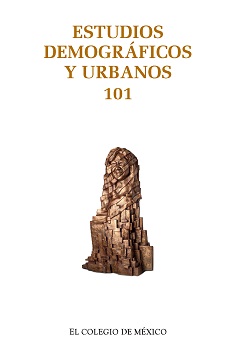Divergent paths to low mortality? The increase in life expectancy and the inequality in the number of lived years in Latin America and Europe
Published 2019-03-25
Keywords
- mortality,
- inequality,
- survival,
- distribution of years of life,
- Latin America
- Europe ...More
How to Cite
-
Abstract2829
-
PDF (español)841
-
En línea (español)715
Downloads
Copyright (c) 2019 Estudios Demográficos y Urbanos

This work is licensed under a Creative Commons Attribution-NonCommercial-NoDerivatives 4.0 International License.
Metrics
Abstract
One of the main demographic changes experienced by Latin America during the second half of the 20th century has been the increase in life expectancy. One problem with this indicator is that it reflects the average level of mortality, but not the inequality in the distribution of the years lived. The purpose of this paper is to perform a comparative historical analysis of mortality in Latin America and Europe that will show whether or not there are differences in their levels of inequality in the distribution of ages at death. The evidence suggests that there is no specific experience in the historical pattern of association between level of mortality and inequality in ages at death. Gaps between countries regarding inequality levels are constant throughout the transition to low mortality. However, there may be an association between social inequality and inequality in ages at death.
References
- Anand, S. (1983). Inequality and poverty in Malaysia: Measurement and decomposition. Nueva York: Oxford University Press.
- Atkinson, A. (1970). On the measurement of inequality. Journal of Economic Theory, 2(3) 244-263. Recuperado de https://www.sciencedirect.com/science/article/pii/0022053170900396 DOI: https://doi.org/10.1016/0022-0531(70)90039-6
- Behm, H. (2011). Determinantes económicos y sociales de la mortalidad en América Latina. Salud Colectiva, 7(2), 231-253. Recuperado de http://www.redalyc.org/articulo.oa?id=73122320014 DOI: https://doi.org/10.18294/sc.2011.382
- Bronfman, M. y Tuirán, R. A. (1984). La desigualdad social ante la muerte: clases sociales y mortalidad en la niñez. Cuadernos Médico Sociales, 29/30, 53-75.
- Celade (2003). América Latina y el Caribe: el envejecimiento de la población. Santiago de Chile: Centro Latinoamericano y Caribeño de Demografía, Naciones Unidas.
- Chackiel, J. (2004). La dinámica demográfica en América Latina. Santiago de Chile: Naciones Unidas, Centro Latinoamericano y Caribeño de Demografía (Celade), Comisión Económica para América Latina (CEPAL).
- Donoso, E. (2004). Desigualdad en mortalidad infantil entre las comunas de la provincia de Santiago. Revista Médica de Chile, 132(4), 461-466. Recuperado de https://scielo.conicyt.cl/pdf/rmc/v132n4/art08.pdf DOI: https://doi.org/10.4067/S0034-98872004000400008
- Frenk, J., Lozano, R. y Bobadilla, J. L. (1994). La transición epidemiológica en América Latina. Notas de Población, 22(60), 79-101. Santiago de Chile: Comisión Económica para América Latina y el Caribe. Recuperado de https://repositorio.cepal.org/handle/11362/12808
- Fries, J. (1980). Aging, natural death, and the compression of morbidity. The New England Journal of Medicine, 303(3), 130-135. Recuperado de https://www.researchgate.net/publication/15816171_Aging_Natural_Death_and_the_Compression_of_Morbidity DOI: https://doi.org/10.1056/NEJM198007173030304
- Gangas, P. (2003). Desigualdad y pobreza: América Latina y Europa desde 1950. Política y Cultura, 20, 29-51. Recuperado de http://www.redalyc.org/pdf/267/26702002.pdf
- Haeberer, M., Noguer, I. y Mújica, O. (2015). Desigualdades educacionales en mortalidad y supervivencia de mujeres y hombres de las Américas, 1990-2010. Revista Panamericana de Salud Pública, 38(2), 89-95. Recuperado de http://iris.paho.org/xmlui/handle/123456789/10043
- Human Mortality Database (varios años). Berkeley, CA: University of California / Rostock, Alemania: Max Planck Institute for Demographic Research. Recuperado de www.mortality.org
- Illsey, R. y Le Grand, J. (1987). The measurement of inequality in health. En A. Williams (ed.), Health and economics (pp. 13-36). Londres: Macmillan. DOI: https://doi.org/10.1007/978-1-349-18800-0_2
- Kannisto, V., Lauritsen, J., Thatcher, R. y Vaupel, J. (1994). Reduction of mortality at advanced ages: Several decades of evidence from 27 countries. Population and Development Review, 20(4), 793-810. Recuperado de https://www.jstor.org/stable/2137662?seq=1#page_scan_tab_contents DOI: https://doi.org/10.2307/2137662
- Le Grand, J. (1987). Inequalities in health: Some international comparisons. European Economic Review, 31, 182-191. Recuperado de https://www.sciencedirect.com/science/article/pii/0014292187900304 DOI: https://doi.org/10.1016/0014-2921(87)90030-4
- Le Grand, J. (1989). An international comparison of distributions of ages-at-death. En J. Fox (ed.), Health inequalities in European countries. Aldershot: Gower Press.
- Llorca, J., Prieto, M. D., Alvarez, C. y Delgado-Rodriguez, M. (1998). Age differential is Spain,1900-1991. Journal of Epidemiology Community Health, 52, 259-261. Recuperado de http://jech.bmj.com/content/jech/52/4/259.full.pdf DOI: https://doi.org/10.1136/jech.52.4.259
- Lynch, S. y Brown, S. (2001). Reconsidering mortality compression and deceleration: An alternative model of mortality rates. Demography, 38(1), 79-95. Recuperado de https://link.springer.com/article/10.1353/dem.2001.0007 DOI: https://doi.org/10.1353/dem.2001.0007
- Palloni, A. y Pinto, G. (2011). Adult mortality in Latin America and the Caribean. En R. Rogers y E. Crimmins (eds.), International Handbook of Adult Mortality (pp. 101-132). Dordrecht: Springer. DOI: https://doi.org/10.1007/978-90-481-9996-9_5
- Palloni, A., Pinto, G. y Beltrán, H. (2014). Latin American Mortality Database (LAMBdA). Madison: University of Wisconsin. Recuperado de https://www.ssc.wisc.edu/cdha/latinmortality/
- Palloni, A., Pinto, G. y Beltrán, H. (2015). Estimation of life tables 1850-2010: Adjustments for relative completeness and age misreporting. En A. Palloni, G. Pinto y H. Beltran-Sánchez (eds.), Two centuries of mortality in Latin America: From hunger to longevity (pp.3-73). Recuperado de http://www.ssc.wisc.edu/cdha/latinmortality/wp-content/uploads/book_Ch2.pdf
- Preston, S., Heuveline, P. y Guillot, M. (2001). Demography. Measuring and modeling population processes. Massachusetts: Blackwell.
- Rosero-Bixby, L. (2018). High life expectancy and reversed socioeconomic gradients of elderly people in Mexico and Costa Rica. Demographic Research, 38(3), 95-108. Recuperado de https://www.demographic-research.org/volumes/vol38/3/38-3.pdf DOI: https://doi.org/10.4054/DemRes.2018.38.3
- Sen, A. (1973). On economic inequality. Oxford: Clarendon Press. DOI: https://doi.org/10.1093/0198281935.001.0001
- Shkolnikov, V., Andreev, E. y Begun, A. (2003). Gini coefficient as a life table function: Computation from discrete data, decomposition of differences and empirical examples. Demographic Research, 8(11), 305-358. Recuperado de https://www.demographic-research.org/volumes/vol8/11/8-11.pdf DOI: https://doi.org/10.4054/DemRes.2003.8.11
- Silber, J. (1988). On inequality before death and life table summary measures. Genus, 44(1/2), 25-39. Recuperado de https://www.jstor.org/stable/29788936?seq=1#metadata_info_tab_contents
- Wilmoth, J., Andreev, K., Jdanov, D. y Glei, D. (2007). Methods protocol for the Human Mortality Database. Recuperado de https://www.researchgate.net/publication/241173442_Methods_Protocol_for_the_Human_Mortality_Database
- Wilmoth, J. R. y Horiuchi, S. (1999). Rectangularization revisited: Variability in age at death within human populations. Demography, 36(4), 475-495. Recuperado de https://www.jstor.org/stable/2648085?seq=1#metadata_info_tab_contents DOI: https://doi.org/10.2307/2648085


